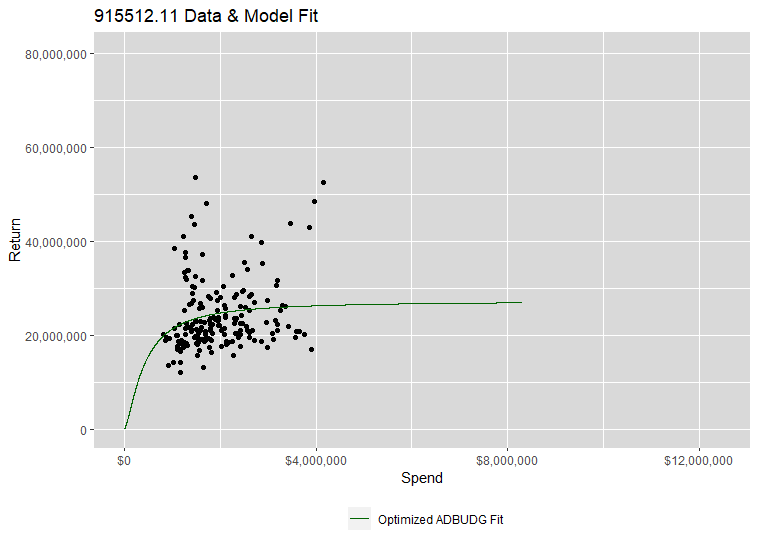I was trying to build Hill customized function, and wasn't successful with that. COuld you help me to find out what is wrong with the following:
str(db_bbw_new)
channelName = as.character(db_bbw_new$adcost[1])
maxX = 1.5*max(db_bbw_new$adcost) # myData$Spend
maxY = 1.5*max(db_bbw_new$y) #myData$Retur?
Return <- db_bbw_new$y
Spend <- db_bbw_new$adcost
myPlotDataDF = data.frame(Return = db_bbw_new$y, Spend = db_bbw_new$adcost)
?ggplot()
simpleScatterPlot <- ggplot(myPlotDataDF, aes(x = Spend, y = Return)) +
geom_point(color="black") +
theme(panel.background = element_rect(fill = 'grey85'),
panel.grid.major = element_line(colour = "white")) +
coord_cartesian(ylim = c(0,maxY), xlim = c(0,maxX)) +
scale_x_continuous(labels = scales::dollar) +
scale_y_continuous(labels = scales::comma) +
ggtitle(paste(channelName))
simpleScatterPlot
#We need a model that exhibits diminishing marginal returns. Diminishing marginal return means that the rate of return will decrease the more you spend. The ADBUDG model is a very flexible model that incorporates diminishing marginal returns. The ADBUDG model is defined as follows:
Ufun<-function(x, Spend, Return) {
predictedReturn = x[2] + (x[1] - x[2])*((Spend^x[3])/(x[4] + (Spend^x[3])))
errorSq = (predictedReturn - Return)^2
sumSqError = sum(errorSq)
return(sumSqError)
}
#Let's create some start values, as well as upper and lower bounds:
startValVec = c(2000000,10,1.5, 90000000)
minValVec = c(0,0, 1.01 ,0)
maxValVec = c(400000000, 400000000, 2, 600000000)
optim.parms<-nlminb(objective=Ufun,start=startValVec,
lower=minValVec,
upper=maxValVec,
control=list(iter.max=1000000,eval.max=20000),
Spend = db_bbw_new$adcost,
Return = db_bbw_new$y)
optim.parms
#Now that the plot will include the ADBUDG model, building the data frame to feed into ggplot2 is a little more complex.
a = optim.parms$par[1]
b = optim.parms$par[2]
c = optim.parms$par[3]
d = optim.parms$par[4]
curveDFx = seq(from=0, to=max(db_bbw_new$adcost)*2, length.out=10000)
curveDFy = b+(a-b)*((curveDFx^c)/(d+(curveDFx^c)))
curveDF = data.frame(Spend = curveDFx, Return=curveDFy)
maxX = 1.5*max(curveDFx, max(db_bbw_new$adcost))
maxY = 1.5*max(curveDFy, max(db_bbw_new$y))
myPlotDataDF = data.frame(Return = db_bbw_new$y, Spend = db_bbw_new$adcost)
optimLineDF = data.frame(Spend = curveDFx, Return = curveDFy)
scatterPlotPlusFit <- ggplot(myPlotDataDF, aes(x = Spend, y = Return)) +
geom_point(color="black", shape = 16) +
theme(panel.background = element_rect(fill = 'grey85'),
panel.grid.major = element_line(colour = "white")) +
geom_line(data = optimLineDF, aes(x = Spend, y = Return, color = "darkgreen")) +
scale_color_manual(labels = "Optimized ADBUDG Fit",values=c('darkgreen')) +
theme(legend.title=element_blank(), legend.position = "bottom") +
coord_cartesian(ylim = c(0,maxY), xlim = c(0,maxX)) +
scale_x_continuous(labels = scales::dollar) +
scale_y_continuous(labels = scales::comma) +
ggtitle(paste(channelName, "Data & Model Fit", sep = " "))
scatterPlotPlusFit
